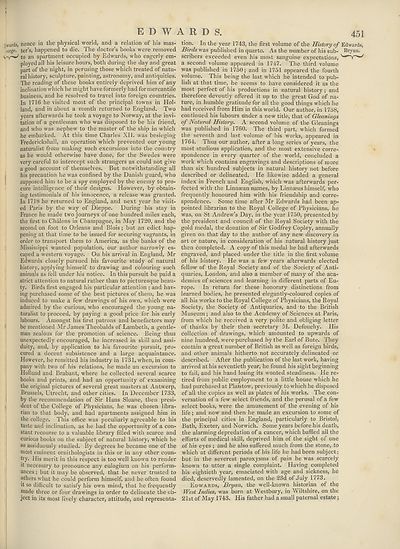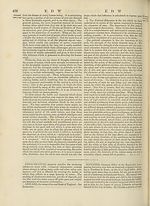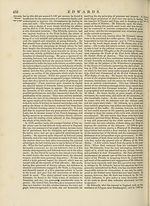Encyclopaedia Britannica > Volume 8, DIA-England
(461) Page 451 - Edwards
Download files
Complete book:
Individual page:
Thumbnail gallery: Grid view | List view

i ffards, nence in the physical world, and a relation of his mas-
■orge. ter’s, happened to die. The doctor’s books were removed
to an apartment occupied by Edwards, who eagerly em¬
ployed all his leisure hours, both during the day and great
part of the night, in perusing those which treated of natu¬
ral history, sculpture, painting, astronomy, and antiquities.
The reading of these books entirely deprived him of any
inclination which he might have formerly had for mercantile
business, and he resolved to travel into foreign countries.
In 1716 he visited most of the principal towns in Hol¬
land, and in about a month returned to England. Two
years afterwards he took a voyage to Norway, at the invi¬
tation of a gentleman who was disposed to be his friend,
and who was nephew to the master of the ship in which
he embarked. At this time Charles XII. was besieging
Frederickshall, an operation which prevented our young
naturalist from making such excursions into the country
as he would otherwise have done, for the Swedes were
very careful to intercept such strangers as could not give
a good account of themselves. But notwithstanding all
his precaution he was confined by the Danish guard, who
supposed him to be a spy employed by the enemy to pro¬
cure intelligence of their designs. However, by obtain¬
ing testimonials of his innocence, a release was granted.
In 1718 he returned to England, and next year he visit¬
ed Paris by the way of Dieppe. During his stay in
France he made two journeys of one hundred miles each,
the first to Chalons in Champagne, in May 1720, and the
second on foot to Orleans and Blois; but an edict hap¬
pening at that time to be issued for securing vagrants, in
order to transport them to America, as the banks of the
Mississippi w’anted population, our author narrowly es¬
caped a western voyage. On his arrival in England, Mr
Edwards closely pursued his favourite study of natural
history, applying himself to drawing and colouring such
animals as fell under his notice. In this pursuit he paid a
strict attention to natural rather than to picturesque beau¬
ty. Birds first engaged his particular attention ; and hav¬
ing purchased some of the best pictures of them, he was
induced to make a few drawings of his own, which were
admired by the curious, who encouraged the young na¬
turalist to proceed, by paying a good price for his early
labours. Amongst his first patrons and benefactors may
be mentioned Mr James Theobalds of Lambeth, a gentle¬
man zealous for the promotion of science. Being thus
unexpectedly encouraged, he increased in skill and assi¬
duity, and, by application to his favourite pursuit, pro¬
cured a decent subsistence and a large acquaintance.
However, he remitted his industry in 1731, when, in com¬
pany with two of his relations, he made an excursion to
Holland and Brabant, where he collected several scarce
books and prints, and had an opportunity of examining
the original pictures of several great masters at Antwerp,
Brussels, Utrecht, and other cities. In December 1733,
by the recommendation of Sir Hans Sloane, then presi¬
dent of the College of Physicians, he was chosen libra¬
rian to that body, and had apartments assigned him in
the college. This office was peculiarly agreeable to his
taste and inclination, as he had the opportunity of a con¬
stant recourse to a valuable library filled with scarce and
curious books on the subject of natural history, which he
so assiduously studied. By degrees he became one of the
most eminent ornithologists in this or in any other coun¬
try. His merit in this respect is too well known to render
it necessary to pronounce any eulogium on his perform¬
ances ; but it may be observed, that he never trusted to
others what he could perform himself, and he often found
it so difficult to satisfy his own mind, that he frequently
made three or four drawings in order to delineate the ob¬
ject in its most lively character, attitude, and representa¬
tion. In the year 1743, the first volume of the History of Edwards,
Birds was published in quarto. As the number of his sub- Bryan,
scribers exceeded even his most sanguine expectations,
a second volume appeared in 1747. The third volume
was published in 1750; and in 1751 appeared the fourth
volume. This being the last which he intended to pub¬
lish at that time, he seems to have considered it as the
most perfect of his productions in natural history ; and
therefore devoutly offered it up to the great God of na¬
ture, in humble gratitude for all the good things which he
had received from Him in this world. Our author, in 1758,
continued his labours under a new title, that of Gleanings
of Natural History. A second volume of the Gleanings
was published in 1760. The third part, which formed
the seventh and last volume of his works, appeared in
1764. Thus our author, after a long series of years, the
most studious application, and the most extensive corre¬
spondence in every quarter of the world, concluded a
work which contains engravings and descriptions of more
than six hundred subjects in natural history not before
described or delineated. He likewise added a general
index in French and English, which was afterwards per¬
fected with the Linnsean names, by Linnaeus himself, who
frequently honoured him with his friendship and corre¬
spondence. Some time after Mr Edwards had been ap¬
pointed librarian to the Royal College of Physicians, he
was, on St Andrew’s Day, in the year 1750, presented by
the president and council of the Royal Society with the
gold medal, the donation of Sir Godfrey Copley, annually
given on that day to the author of any new discovery in
art or nature, in consideration of his natural history just
then completed. A copy of this medal he had afterwards
engraved, and placed under the title in the first volume
of his history. He was a few years afterwards elected
fellow of the Royal Society and of the Society of Anti¬
quaries, London, and also a member of many of the aca¬
demies of sciences and learning in different parts of Eu¬
rope. In return for these honorary distinctions from
learned bodies, he presented elegantly-coloured copies of
all his works to the Royal College of Physicians, the Royal
Society, the Society of Antiquaries, and to the British
Museum; and also to the Academy of Sciences at Paris,
from which he received a very polite and obliging letter
of thanks by their then secretary M. Defouchy. His
collection of drawings, which amounted to upwards of
nine hundred, were purchased by the Earl of Bute. They
contain a great number of British as well as foreign birds,
and other animals hitherto not accurately delineated or
described. After the publication of the last work, having
arrived at his seventieth year, he found his sight beginning
to fail, and his hand losing its wonted steadiness. He re¬
tired from public employment to a little house which he
had purchased at Plaistow, previously to which he disposed
of all the copies as well as plates of his works. The con¬
versation of a few select friends, and the perusal of a few
select books, were the amusement of the evening of his
life; and now and then he made an excursion to some of
the principal cities in England, particularly to Bristol,
Bath, Exeter, and Norwich. Some years before his death,
the alarming depredation of a cancer, which baffled all the
efforts of medical skill, deprived him of the sight of one
of his eyes ; and he also suffered much from the stone, to
which at different periods of his life he had been subject;
but in the severest paroxysms of pain he was scarcely
known to utter a single complaint. Having completed
his eightieth year, emaciated with age and sickness, he
died, deservedly lamented, on the 23d of July 1773.
Edwards, Bryan, the well-known historian of the
West Indies, was born at Westbury, in Wiltshire, on the
21st of May 1743. His father had a small paternal estate;
■orge. ter’s, happened to die. The doctor’s books were removed
to an apartment occupied by Edwards, who eagerly em¬
ployed all his leisure hours, both during the day and great
part of the night, in perusing those which treated of natu¬
ral history, sculpture, painting, astronomy, and antiquities.
The reading of these books entirely deprived him of any
inclination which he might have formerly had for mercantile
business, and he resolved to travel into foreign countries.
In 1716 he visited most of the principal towns in Hol¬
land, and in about a month returned to England. Two
years afterwards he took a voyage to Norway, at the invi¬
tation of a gentleman who was disposed to be his friend,
and who was nephew to the master of the ship in which
he embarked. At this time Charles XII. was besieging
Frederickshall, an operation which prevented our young
naturalist from making such excursions into the country
as he would otherwise have done, for the Swedes were
very careful to intercept such strangers as could not give
a good account of themselves. But notwithstanding all
his precaution he was confined by the Danish guard, who
supposed him to be a spy employed by the enemy to pro¬
cure intelligence of their designs. However, by obtain¬
ing testimonials of his innocence, a release was granted.
In 1718 he returned to England, and next year he visit¬
ed Paris by the way of Dieppe. During his stay in
France he made two journeys of one hundred miles each,
the first to Chalons in Champagne, in May 1720, and the
second on foot to Orleans and Blois; but an edict hap¬
pening at that time to be issued for securing vagrants, in
order to transport them to America, as the banks of the
Mississippi w’anted population, our author narrowly es¬
caped a western voyage. On his arrival in England, Mr
Edwards closely pursued his favourite study of natural
history, applying himself to drawing and colouring such
animals as fell under his notice. In this pursuit he paid a
strict attention to natural rather than to picturesque beau¬
ty. Birds first engaged his particular attention ; and hav¬
ing purchased some of the best pictures of them, he was
induced to make a few drawings of his own, which were
admired by the curious, who encouraged the young na¬
turalist to proceed, by paying a good price for his early
labours. Amongst his first patrons and benefactors may
be mentioned Mr James Theobalds of Lambeth, a gentle¬
man zealous for the promotion of science. Being thus
unexpectedly encouraged, he increased in skill and assi¬
duity, and, by application to his favourite pursuit, pro¬
cured a decent subsistence and a large acquaintance.
However, he remitted his industry in 1731, when, in com¬
pany with two of his relations, he made an excursion to
Holland and Brabant, where he collected several scarce
books and prints, and had an opportunity of examining
the original pictures of several great masters at Antwerp,
Brussels, Utrecht, and other cities. In December 1733,
by the recommendation of Sir Hans Sloane, then presi¬
dent of the College of Physicians, he was chosen libra¬
rian to that body, and had apartments assigned him in
the college. This office was peculiarly agreeable to his
taste and inclination, as he had the opportunity of a con¬
stant recourse to a valuable library filled with scarce and
curious books on the subject of natural history, which he
so assiduously studied. By degrees he became one of the
most eminent ornithologists in this or in any other coun¬
try. His merit in this respect is too well known to render
it necessary to pronounce any eulogium on his perform¬
ances ; but it may be observed, that he never trusted to
others what he could perform himself, and he often found
it so difficult to satisfy his own mind, that he frequently
made three or four drawings in order to delineate the ob¬
ject in its most lively character, attitude, and representa¬
tion. In the year 1743, the first volume of the History of Edwards,
Birds was published in quarto. As the number of his sub- Bryan,
scribers exceeded even his most sanguine expectations,
a second volume appeared in 1747. The third volume
was published in 1750; and in 1751 appeared the fourth
volume. This being the last which he intended to pub¬
lish at that time, he seems to have considered it as the
most perfect of his productions in natural history ; and
therefore devoutly offered it up to the great God of na¬
ture, in humble gratitude for all the good things which he
had received from Him in this world. Our author, in 1758,
continued his labours under a new title, that of Gleanings
of Natural History. A second volume of the Gleanings
was published in 1760. The third part, which formed
the seventh and last volume of his works, appeared in
1764. Thus our author, after a long series of years, the
most studious application, and the most extensive corre¬
spondence in every quarter of the world, concluded a
work which contains engravings and descriptions of more
than six hundred subjects in natural history not before
described or delineated. He likewise added a general
index in French and English, which was afterwards per¬
fected with the Linnsean names, by Linnaeus himself, who
frequently honoured him with his friendship and corre¬
spondence. Some time after Mr Edwards had been ap¬
pointed librarian to the Royal College of Physicians, he
was, on St Andrew’s Day, in the year 1750, presented by
the president and council of the Royal Society with the
gold medal, the donation of Sir Godfrey Copley, annually
given on that day to the author of any new discovery in
art or nature, in consideration of his natural history just
then completed. A copy of this medal he had afterwards
engraved, and placed under the title in the first volume
of his history. He was a few years afterwards elected
fellow of the Royal Society and of the Society of Anti¬
quaries, London, and also a member of many of the aca¬
demies of sciences and learning in different parts of Eu¬
rope. In return for these honorary distinctions from
learned bodies, he presented elegantly-coloured copies of
all his works to the Royal College of Physicians, the Royal
Society, the Society of Antiquaries, and to the British
Museum; and also to the Academy of Sciences at Paris,
from which he received a very polite and obliging letter
of thanks by their then secretary M. Defouchy. His
collection of drawings, which amounted to upwards of
nine hundred, were purchased by the Earl of Bute. They
contain a great number of British as well as foreign birds,
and other animals hitherto not accurately delineated or
described. After the publication of the last work, having
arrived at his seventieth year, he found his sight beginning
to fail, and his hand losing its wonted steadiness. He re¬
tired from public employment to a little house which he
had purchased at Plaistow, previously to which he disposed
of all the copies as well as plates of his works. The con¬
versation of a few select friends, and the perusal of a few
select books, were the amusement of the evening of his
life; and now and then he made an excursion to some of
the principal cities in England, particularly to Bristol,
Bath, Exeter, and Norwich. Some years before his death,
the alarming depredation of a cancer, which baffled all the
efforts of medical skill, deprived him of the sight of one
of his eyes ; and he also suffered much from the stone, to
which at different periods of his life he had been subject;
but in the severest paroxysms of pain he was scarcely
known to utter a single complaint. Having completed
his eightieth year, emaciated with age and sickness, he
died, deservedly lamented, on the 23d of July 1773.
Edwards, Bryan, the well-known historian of the
West Indies, was born at Westbury, in Wiltshire, on the
21st of May 1743. His father had a small paternal estate;
Set display mode to:
![]() Universal Viewer |
Universal Viewer | ![]() Mirador |
Large image | Transcription
Mirador |
Large image | Transcription
Images and transcriptions on this page, including medium image downloads, may be used under the Creative Commons Attribution 4.0 International Licence unless otherwise stated. ![]()
| Encyclopaedia Britannica > Encyclopaedia Britannica > Volume 8, DIA-England > (461) Page 451 - Edwards |
|---|
| Permanent URL | https://digital.nls.uk/193328998 |
|---|
| Attribution and copyright: |
|
|---|
| Description | Ten editions of 'Encyclopaedia Britannica', issued from 1768-1903, in 231 volumes. Originally issued in 100 weekly parts (3 volumes) between 1768 and 1771 by publishers: Colin Macfarquhar and Andrew Bell (Edinburgh); editor: William Smellie: engraver: Andrew Bell. Expanded editions in the 19th century featured more volumes and contributions from leading experts in their fields. Managed and published in Edinburgh up to the 9th edition (25 volumes, from 1875-1889); the 10th edition (1902-1903) re-issued the 9th edition, with 11 supplementary volumes. |
|---|---|
| Additional NLS resources: |
|

